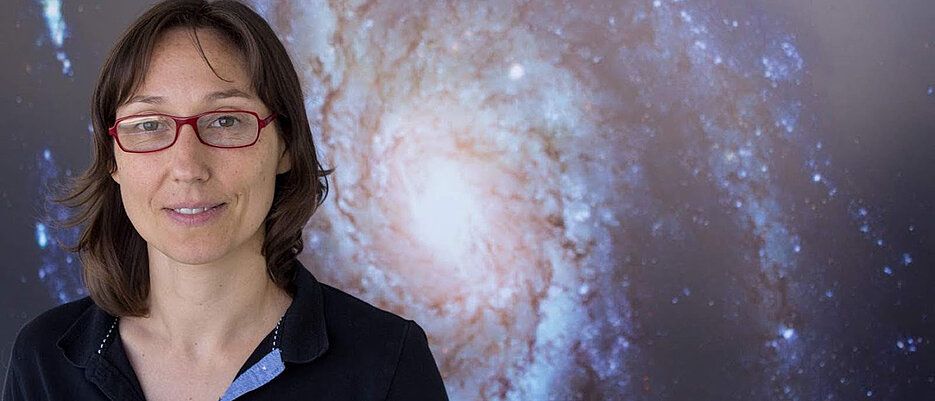Tracking the Origin of Cosmic Neutrinos
11/27/2018Black holes and other extremely high-energy environments in the universe: Sara Buson teaches and conducts research in this field. As a junior professor, she has recently joined the Würzburg Chair of Astronomy.

It's only been a few months since astrophysicist Sara Buson has had a particularly exciting time. In her office at NASA she was busy with a data analysis that in July 2018 culminated in a publication in "Science". The research result described therein was reported worldwide, with headlines like "Source of a cosmic neutrino identified for the first time".
What happened before? One day in September 2017, a high-energy neutrino hit the IceCube particle detector in the Antarctic. This does not happen every day, because neutrinos are difficult to find: they have almost no mass, they hardly interact with matter. They race through the universe and penetrate galaxies, planets and the human body almost without leaving a trace.
High energy indicated cosmic origin
The high energy of the detected neutrino generated considerable excitement – because this suggests that the neutrino did not origin from the sun, but from further away. And where such cosmic neutrinos come from is a century long mystery.
Upon the detection of the high-energy neutrino by the IceCube observatory, the astrophysics community quickly pointed space and ground-based telescopes toward the sky direction where the neutrino originated. Among others, the data collected by the Fermi-LAT gamma-ray space telescope were particularly interesting.
Dr. Buson was among the first scientists to perform a quick-look analysis of this data and promptly alerted the community about the outcome: a known gamma-ray source was coincident with the neutrino direction. Sara Buson and her german colleague Anna Franckowiak, from DESY Research Center Zeuthen near Berlin, were responsible for conducting a detailed study on the gamma-rays / neutrino connection.
Neutrino from another galaxy
The result: Based on gamma rays coming from the same direction, the researchers were able to determine the origin of the cosmic neutrino. It came from beyond the Orion constellation: its birthplace is likely the active galaxy TXS 0506+056, from whose center a supermassive black hole shoots relativistic particle streams, called jets, into the universe.
TXS 0506+056 belongs to a peculiar type of active galaxies usually referred as blazars. In blazars one of the jets points directly towards the Earth: we are literally looking into the barrel of the gun. "At the time of the neutrino detection, the blazar TXS 0506+056 was undergoing the most active phase ever seen over a decade of observations with the Fermi-LAT," says Sara Buson.
Awarded for outstanding research
The outcomes of this research were published in the top magazine “Science”. On October 23, 2018, the leading contribute and effort by Dr. Buson were acknowledged at the italian embassy in Washington (DC), when she was honored with the prestigious “ISSNAF award for young investigators”. This award is assigned every year by the Italian Scientists and Scholars of North America Foundation (ISSNAF) to researchers who have demonstrated excellent commitment to their discipline.
Junior professorship in Würzburg
In the summer of 2018, Sara Buson moved from NASA to Julius-Maximilians-Universität Würzburg (JMU) in Bavaria, Germany. Here she is working as junior Professor for high energy astrophysics at the Chair of Astronomy – a good career move. The Würzburg astrophysics is a world-renowned address for her research, as Buson says.
At JMU, the new professor will continue her research on gamma rays and neutrinos and other "messengers" from the universe. One goal of this work is to better understand the physical processes that occur in extremely high-energy environments – including supermassive black holes and their surroundings.
“Our Universe is plenty of mysteries from which we can learn a lot. Solving them it’s like putting together the pieces of a puzzle. The exiting challenge is that we often don’t know how the final picture will look like, while playing with its tiles we can learn a lot. Being capable of building and understanding the full picture should be the students’ motivation to embrace the astrophysics field,” says Buson.
Career of Sara Buson
Sara Buson was born in 1979 in Pernumia near Padua (Italy). She studied astrophysics at the University of Padua and received her doctorate there. She conducted research as postdoc in Padua for other two years, until when she was awarded the NASA postdoctoral fellowship. In 2015, she moved to the USA in 2015 at NASA's Goddard Space Flight Center in Greenbelt, Maryland. In mid-2018, she joined the high-energy astrophysics group at JMU, as junior professor.
Contact
Prof. Dr. Sara Buson, Chair of Astronomy, University of Würzburg, T +49 931 31-82449, sara.buson@astro.uni-wuerzburg.de






